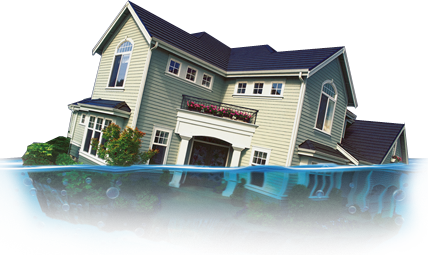
Water is the natural enemy of every wood floor. You do everything you can to stay on top of spills, but you can’t control everything, and now the worst has happened! Your once gleaming hardwood floor has been damaged by water!
What Does Water Do to a Wooden Floor?
Wood is an organic material that can only resist the effects of water for a short time. That’s why expediency is key to preventing damage from occurring. But sometimes, things happen that you can’t plan for. For example, you’re away on vacation and while you’re lying on a beach soaking up the sun, a pipe breaks and floods your kitchen which then remains that way for several days. Now what?
Signs of Water Damage on Wood Floors
Depending on how long the floor was wet, damage can vary. Here are some signs of damage to look for:
1. Staining and/or discoloration
2. Cupping and buckling from absorbed moisture
3. Popping nails
4. Lifting of floorboards (especially at the ends)
5. Mold growth (can occur within 48 hours of flooding)
Considering that the normal moisture content in a typical hardwood floor is somewhere between 6 and 12 percent and a flooded hardwood floor can have a moisture content of up to 40 percent, damage can be severe. Much of it has to do with the amount of time that the floor is exposed to the water. More moisture will be retained if the floor is left to dry on its own.
Deciding Factors for Replacement or Repair
Determining whether a water-damaged wood floor can be repaired or must be torn up and replaced will depend on a number of factors such as:
1. the length of time the floor has been exposed to water
2. whether your floor is solid hardwood or engineered hardwood
3. the severity of the damage (Has the water penetrated into to the subfloor?)
4. the floor’s finish (It can be difficult to match certain stain colors when replacing isolated floorboards, especially if the stain has “mellowed” with time.)
If the damage is minor, the floor can sometimes be saved by replacing affected boards and then sanding and refinishing the whole floor. If the damage is severe or extensive causing significant expansion, the entire floor may need replacing — and sometimes even the subfloor will have to be replaced.

 If you suspect water damage, the first step is to have the floor’s condition assessed by a hardwood flooring professional. Call
If you suspect water damage, the first step is to have the floor’s condition assessed by a hardwood flooring professional. Call 


It was really helpful when you said that discoloration is a sign of water damage. My husband and I have noticed discoloration on our wood floors and we were wondering what the issue is. we’ll have to look into hiring a floor refinishing service to help us with fixing it!
I noticed that my hardwood flooring is getting damaged. I wish I had known that water could damage hardwood floors like this! It would be smart for me to get it repaired correctly so that it looks nice.
Dear Tom Peter Flooring,
I wanted to express my appreciation for your informative blog post titled “Water Damage to Wood Floors: Repair or Replace?” Your article provides valuable insights into the effects of water damage on wood floors and offers guidance on whether to repair or replace them, helping homeowners make informed decisions when faced with such situations.
Your explanation of the potential consequences of water damage to wood floors is commendable. By discussing issues such as cupping, warping, staining, and mold growth, you help readers understand the severity of water damage and its impact on the structural integrity and appearance of their wood floors.
I found your emphasis on prompt action and assessment to be particularly valuable. Your recommendation to address water damage as soon as possible, removing the source of moisture and drying the affected area, is crucial in preventing further damage and minimizing the need for extensive repairs or replacements. Encouraging homeowners to assess the extent of the damage and consult professionals helps them make informed decisions about the appropriate course of action.
The inclusion of specific factors to consider when deciding whether to repair or replace water-damaged wood floors is noteworthy. Your discussion on the severity of the damage, the age and condition of the flooring, and the cost-effectiveness of repairs versus replacement provides readers with a framework to evaluate their options. This helps homeowners weigh the pros and cons and make the best decision for their specific situation.
I appreciate your recommendation to consult professionals for a thorough assessment and restoration. Acknowledging that water damage can have hidden consequences and that professional expertise is required to determine the extent of the damage ensures that homeowners have access to the necessary resources for effective repairs or replacements. Engaging professionals can also provide homeowners with guidance on preventive measures to mitigate future water damage risks.
Furthermore, your mention of preventive measures, such as proper maintenance, regular inspections, and moisture control, is significant. By promoting proactive steps to protect wood floors from water damage, you empower homeowners to take preventive measures and prolong the lifespan of their flooring.
Thank you for sharing your knowledge and expertise through this blog post. Your guidance on water damage to wood floors and the considerations for repair or replacement is invaluable. I will certainly keep your recommendations in mind and share this resource with others who may benefit from your insights.
I recently came across your blog post titled “Water Damage to Wood Floors: Repair or Replace?” and wanted to express my appreciation for the valuable insights and guidance you provide. Your post addresses a common concern among homeowners who have experienced water damage to their wood floors and offers helpful advice on whether to repair or replace them.
Your blog post begins by acknowledging the distressing nature of water damage and the impact it can have on wood floors. By providing a comprehensive overview of the factors to consider when deciding between repair and replacement, you offer readers a valuable resource for making informed decisions.
I found your explanation of the different types of water damage, such as minor, moderate, and severe, to be informative. By describing the characteristics of each level of damage and the associated challenges, you help readers assess the extent of their own flooring damage and better understand the options available to them.
Your post also provides practical tips for assessing the feasibility of repairs, such as checking for signs of cupping, warping, or discoloration. These guidelines empower homeowners to make initial assessments of the damage and determine if repairs are a viable solution.
I appreciate the emphasis you place on consulting with professionals for an accurate assessment and guidance. By highlighting the importance of involving experienced flooring specialists, you ensure that homeowners receive expert advice tailored to their specific situation. This is crucial in determining the best course of action and achieving optimal results.
Additionally, your discussion on the potential benefits of replacement, such as improved aesthetics, durability, and the opportunity to address underlying issues, adds valuable insights to the decision-making process. This comprehensive approach helps readers consider both short-term and long-term factors when weighing repair versus replacement options.
In conclusion, your blog post on water damage to wood floors provides valuable information and guidance to homeowners facing this common issue. By explaining the factors to consider, offering practical assessment tips, and highlighting the importance of professional consultation, you equip readers with the knowledge needed to make informed decisions regarding repair or replacement.
Thank you for sharing your expertise and providing valuable assistance to homeowners dealing with water-damaged wood floors.
I recently came across your article titled “Water Damage to Wood Floors: Repair or Replace?” on your website, and I wanted to commend you for providing valuable insights on dealing with water damage to wood floors. Water damage can be a significant concern for homeowners, and your article offers practical advice to help them assess the extent of the damage and determine whether repair or replacement is the appropriate course of action.
Your article starts by acknowledging the beauty and appeal of wood floors, as well as the vulnerability they have to water damage. By addressing these factors, you establish the importance of understanding the implications of water damage and the need for timely intervention.
I found your explanation of the factors to consider when assessing water damage to wood floors to be particularly helpful. From the type and extent of water exposure to the condition of the flooring and the potential for mold growth, you provide readers with a comprehensive framework for evaluating the damage. This enables homeowners to make informed decisions about the appropriate steps to take in restoring their wood floors.
Furthermore, your article emphasizes the significance of prompt action when dealing with water damage. By highlighting the potential consequences of delayed repairs, such as further deterioration and increased costs, you underscore the importance of addressing water damage as soon as possible.
Additionally, I appreciate your guidance on the repair versus replacement decision. By discussing the circumstances in which repair may be possible and effective, as well as the situations where replacement is the better option, you provide readers with valuable insights into weighing the costs, extent of damage, and long-term viability of their wood floors.
Overall, your article serves as a valuable resource for homeowners dealing with water damage to their wood floors. By providing information on assessing the damage, stressing the importance of prompt action, and offering guidance on repair versus replacement decisions, you empower readers to make informed choices about restoring their wood floors.
Thank you for sharing your expertise and providing practical guidance on water damage to wood floors. I look forward to reading more of your informative content in the future.
https://jgwgroupwaterdamagerestoration.com